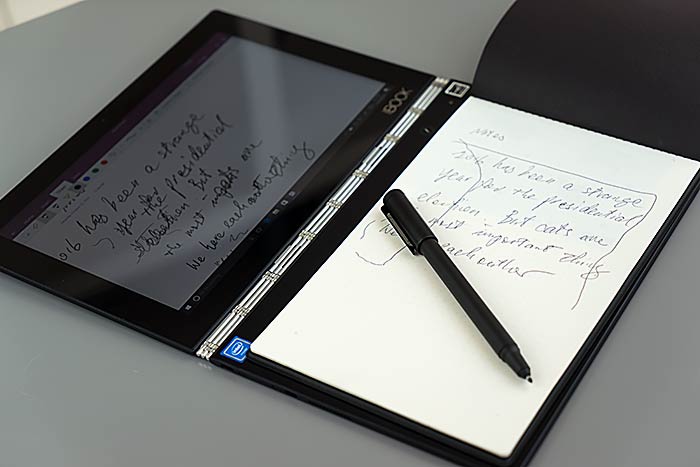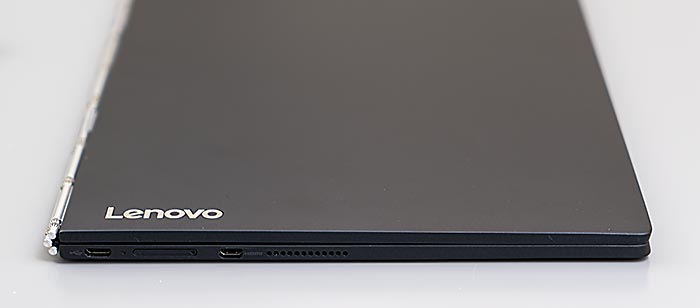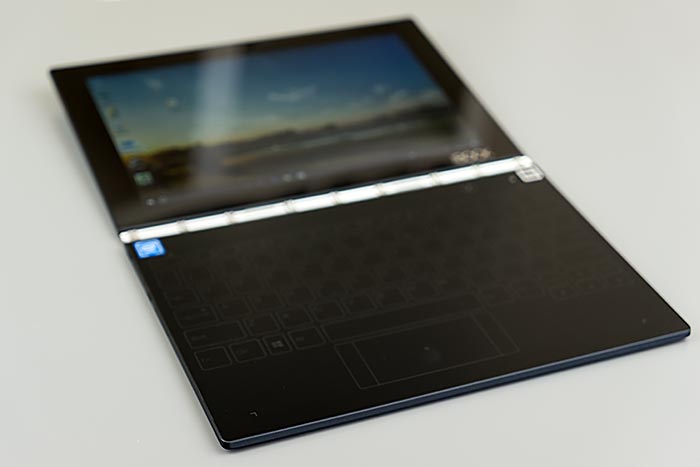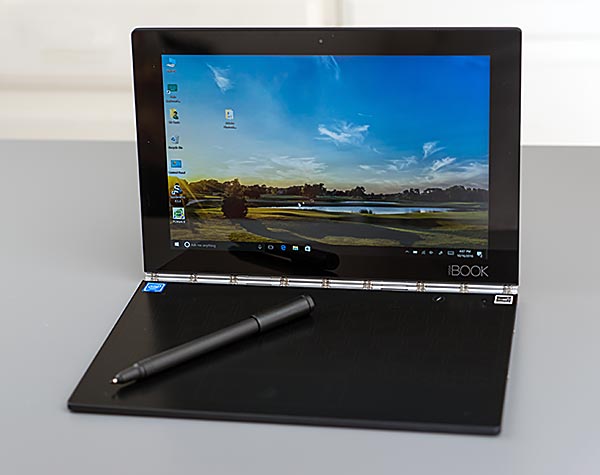|
When you see the 10.1" Lenovo Yoga Book, you'll want it. It's that good looking and that unique. From the matte carbon black magnesium alloy stiff casing to the watchband hinge, it looks like something that might cost one or two thousand dollars. Instead, it's just $500 for the Android model and $550 for the Windows 10 model (they share the same hardware, only the OS is different). If you go with the Android Yoga Book you'll have a few other colors to choose from too, but I particularly like the carbon black because it looks like a classy journal book. This is a convertible like Lenovo's other Yoga laptops--it does laptop, tablet, tent and presentation modes via a 360 degree hinge, and the capacitive keyboard and trackpad are automatically disabled when you rotate it out of laptop position (at least it should, our early model had some issues with it forgetting to do so, but we expect that to be fixed). The Yoga Book has a 1.44 GHz Intel Atom x5-Z8550 CPU with Boost to 2.4 GHz, 4 gigs of RAM, 64 gigs of internal storage, dual band WiFi 802.11ac, Bluetooth and optional multi-carrier LTE 4G with a nano SIM card slot. It weighs just 1.5 lbs. and is a mind-bogglingly skinny 9.6mm (0.38"). Yet it's super stiff and sturdy. Ports are scarce, and this clearly isn't meant to be your main laptop--there's a lone micro USB port (you'll need a micro USB to USB dongle to use USB peripherals) that doubles as the charging port, a 3.5mm combo mic-headphone jack, micro HDMI and a microSD card slot that lives in a smartphone-style pop-out tray with the optional 4G LTE SIM nano card holder. Alas, there's no USB-C, which seems a little old fashioned and less versatile compared to recent competition from the 12" MacBook, Asus ZenBook 3 and HP Spectre. The Yoga Book comes with a digital pen, Yoga Book Pad (a pad of paper with magnetic holder), ball point pen nibs for the pen (the standard digital nib is pre-installed in the pen) and a smartphone size charger with a very short USB cable.
Open the Yoga Book and you'll see that there's no keyboard in the traditional sense--that smooth surface has the faint etched outline of a full keyboard, and when in use the Halo keyboard lights up and seems to appear from nowhere. Lenovo calls this bottom area the Create Pad, because with the press of a button it turns into a Wacom EMR digitizer with included pen that supports palm rejection and 2,048 levels of pressure sensitivity.

The IPS 1920 x 1200 touch screen supports Lenovo's AnyPen technology--the included pen works there, albeit without pressure sensitivity and palm rejection. It works with most any implement that has a modicum of metal in its tip--ballpoint pens, lead pencils... Lenovo has incorporated AnyPen in previous Android tablet models and they invited us to try writing with screwdrivers and scissors (we did, the display was undamaged). With the Yoga Book there's no such invitation, so we haven't tried to write with anything other than the included pen. That pen has a removable nib--one is a traditional fine Wacom tip and the other is a ballpoint pen. We used both on the display and the ballpoint left faint ink traces that wiped off. I personally would rather not use an ink pen on my capacitive touch screen, but that feature does work.

So what's with the pen nib that's actually an ink pen? The Yoga Book's bottom Create Pad digitizer uses similar technology to Wacom's own Bamboo Slate: you can place a pad of paper (everyday normal paper, not special stuff) and write or draw on it with the ballpoint pen inserted in the Wacom pen. Lenovo includes a magnetic Book Pad holder with lined A5 paper, but you can use anything you want--graph paper, calligraphy paper or art paper. And yes, the pen really works through the entire pad of paper--nice! Whatever you write or draw will appear on screen in the program of your choice, be it OneNote, ArtRage, Adobe PDF or Photoshop. The reproduction is faithful. Lenovo says they're targeting the Yoga Book at young professionals, and I get why the "grew up with the iPad" generation might be comfortable with the capacitive zero travel keyboard, but I do have a hard time believing they're so wedded to pen and paper. That feature seems better suited to older users who've never grown comfortable with writing on glass screens. The Create Pad's surface (should you choose to forgo the paper) has a non-slick feel, similar to Wacom's USB digitizer tablets that plug into a PC or Mac. I don't think anyone would want to take notes that way, because you're writing blind--you'd have to move your gaze from the tablet portion to the screen to see what you're writing. Though some pro photographers still use Wacom USB tablets like the Intuos, I suspect they're rolling that way because they're using Macs and have no touch screen or active digitizer options like Surface Pro 4 or the Lenovo ThinkPad X1 Yoga. Lenovo argues that this way is better (effectively, the old USB tablet way--working blind on a blank black surface) because your hand doesn't block your view. I haven't heard note-takers complain that their hand blocks their view, nor do sketch artists and painters complain about their pencils and brushes. As someone who does paint and draw digitally, I feel the way many graphic artists do: the day we got the ability to draw directly on screen was liberation day. A photo editor might prefer to not block her view when making a careful masking selection, but as someone who also edits photos and is seriously into photography and Photoshop advanced use, I still find the indirection of a separate drawing pad leads to difficulties with accuracy too.
That Keyboard
The capacitive keyboard is exactly like using the on-screen iPad or Surface Pro 4 keyboard, only bigger. The Yoga Book has a 10" netbook footprint, and a keyboard sized to match (a little wider since it goes nearly edge to edge). I'm very comfortable typing on Android and iPad on-screen keyboards, so the Lenovo capacitive keyboard is fine for short typing sessions. I tried for days, and couldn't come to love it for long form writing, such as writing this review. Why? It has haptic feedback and auditory feedback (too loud, but you can turn it off), so you have some sense of making positive contact with each virtual key, but that's it for tactile feel. Even the old Surface Pro Touch Cover was more tactile. OK, I might be able to live with that, but it's hard to touch type when you're often looking at the keyboard to check your finger position. OK, I could live with that too-- but should I have to just because it looks so cool and allows for a thinner device? Dubious. The deal breaker for long form typing is that you can't rest your fingers ever so lightly on the keys because they're very sensitive and register the slightest touch. That means keeping your elbows bent at a constant 90 degrees and raising your hands completely off the keys, which is very tiring on the shoulders. And forget about typing on the bouncy bus or train. The Halo keyboard would be much better if it used something like Force Touch--require a bit of pressure to actuate the keys and that would allow touch typists to gently rest their home fingers on the f and j keys, and slight contact with other keys wouldn't create a mess of word jumble. Oh well... it looks so darned cool!

The Trackpad
Like the keyboard, the trackpad is a virtual capacitive affair with right and left click buttons at the sides rather than along the bottom. There's simply not enough space to fit them below, and the trackpad's height (but not width) is already limited. The trackpad works OK and supports two-finger scrolling, though it's too short to do much of that. What doesn't work well is that the trackpad is automatically temporarily disabled if you touch a virtual keyboard key, and the spacebar is so close to the trackpad that you'll accidentally touch the spacebar all the time (remember, there's no tactile feel to warn you that your finger has wandered too far north). Suddenly, mid-mouse, the trackpad seems to stop dead and your file drops goodness knows where. You'll have to tap the dot in the center of the trackpad to activate it again (rather than wait for the deactivation to time out eventually). Clearly, Lenovo noticed the problem too since they added that little activation dot. Lenovo could add a physical ridge around the trackpad to help keep us on the trackpad, but that would get in the way of drawing. I honestly think I'd love a version of the Yoga Book that ditches the digitizer in the base and went all out trying to give us a fantastic virtual keyboard with force touch and physical guide lines to aid in typing and mousing. I'd be thrilled to have just a good Wacom digitizer in the display in place of AnyPen.
Windows or Android?
Lenovo first designed the Yoga Book as an Android device, and that makes the best sense given the challenges that the keyboard and trackpad offer. Most folks don't use mobile OS tablets to write War and Peace, and Android's user interface is perfectly touch-centric so you can use your finger or the pen rather than the trackpad. You're probably using your Android tablet for email, Facebook, streaming video and occasional Office document edits rather than serious long form business work. Lenovo has a few value-added software touches that are Android-only too: you can write on the Create Pad without turning on the screen (this saves battery, though battery life is honestly stellar). The Android model ships with TouchPal, a system-wide auto-correct app that takes care of those generally more common capacitive keyboard typos.

For those worrying about bloatware on the Windows version-- nothing to see here. This is a very clean Windows 10 Home 64 bit experience with no bloatware. Lenovo loads their Halo keyboard app and drivers necessary for the features to work, but nothing else. In fact, there isn't even a Lenovo updater program, which we'd have liked to see since it helps users keep their drivers up to date without hunting on the Lenovo support website.
|
|

